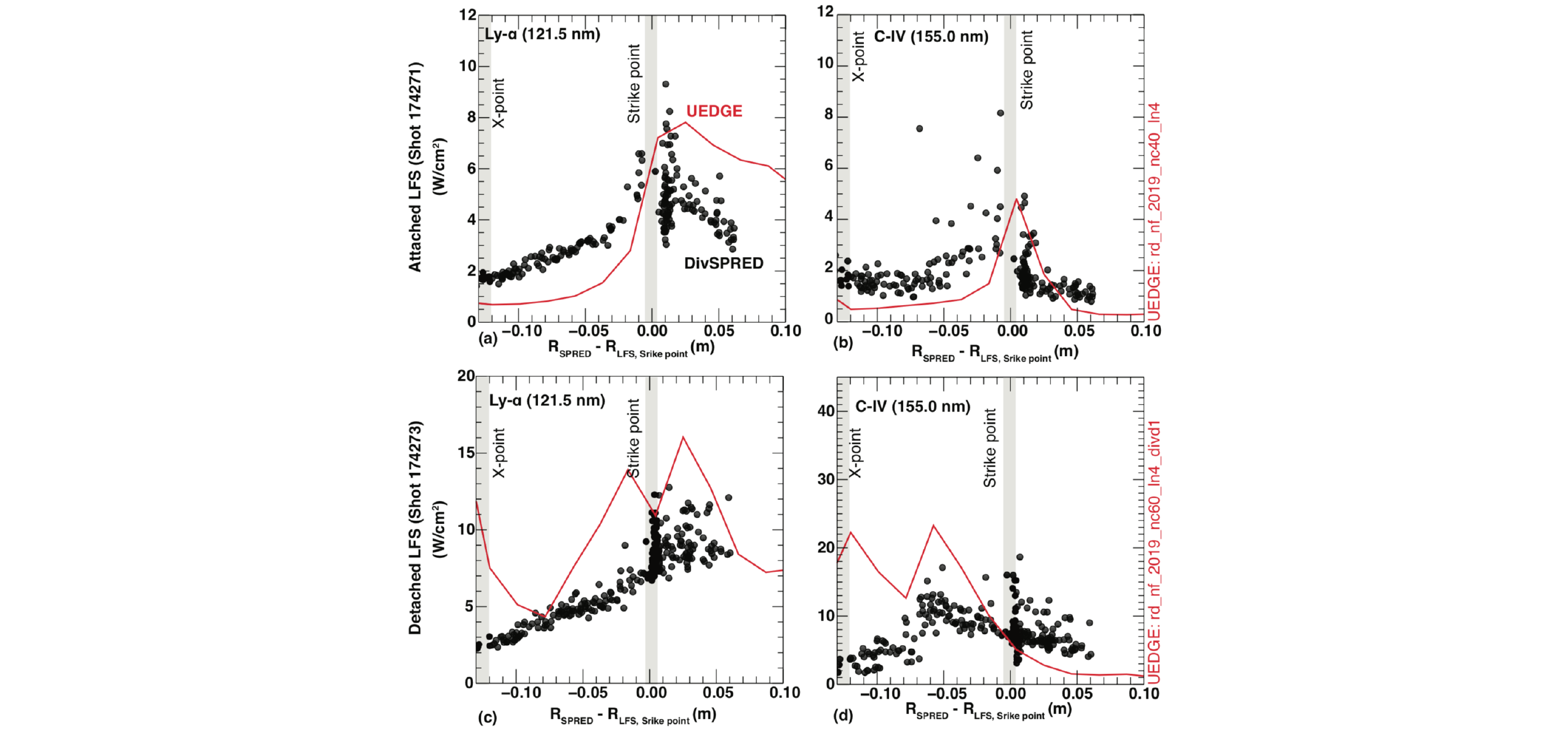Speaker
Description
Recent analysis leveraging the broad array of measurable plasma parameters on the DIII-D tokamak has been used to elucidate the physics underlying detachment processes in the divertor and reveal the 2D nature of detachment important for design of detachment scenarios for next step devices. The dominant role of EUV/VUV radiation for radiative power exhaust has been established experimentally with accompanying spectroscopy leveraged alongside collisional radiative modeling to calculate the impurity density and charge-state distribution in the divertor. 2D measurement of critical plasma parameters for power exhaust studies ($n_e$, $T_e$, P$_\text{rad}$, $E_\text{VUV/EUV}$) reveal a greater radial emission extent compared to UEDGE fluid modeling simulations. This larger extent provides opportunity for greater dissipation volume, but also further demonstrates that fully-2D simulations including cross-field drifts are required for detachment studies working towards a predictive capability of divertor heat loads.
A combination of EUV/VUV-VIS-IR spectroscopy, ColRadPy collisional radiative modeling (1), and 2D $T_e$ and $n_e$ measurements from Divertor Thompson Scattering has been used to infer impurity densities in the divertor. This analysis primarily uses the EUV/VUV resonance lines that make up the vast majority of radiative emission ($\sim$>95% (2)) and are particularly well suited for determining ground-state densities. Inter-ELM intrinsic carbon impurity fraction was found to be $\sim$5% in attached H-mode conditions, falling to $\sim$0.5% in detached conditions while maintaining about the same total carbon density. UEDGE modelling with a full physics drift model similarly shows a reduction in impurity concentration in detachment but limited to a $2.8 \times$ drop. Using the same set of calibrated EUV/VUV spectroscopy measurements, the carbon population in unseeded discharges is inferred to be dominated by C$^{4+}$ in the divertor whereas detached plasmas show highly radiating narrow bands of C$^{2+}$ and C$^{3+}$ at the detachment front. Figure 1 shows these charge state distributions for a partially detached plasma with $\mathbf{B} \times \nabla B$ drift towards the primary X-point in DIII-D’s ‘shelf’ open divertor (4.5MW, 1.8T, 0.9MA) alongside the associated UEDGE predictions. In nitrogen seeded detached cases the additional available charge state results in a slightly increased range of radiating species (N$^{2+}$ to N$^{4+}$ with $\sim$2eV of additional $T_e$ range) in a regime dominated by N$^{3+}$ and N$^{4+}$ ions. The charge state distribution comparison with UEDGE modeling displays quantitatively similar 2D profiles to those experimentally inferred albeit with an additional charge-state mixing caused by the finite lifetime of ions and transportation via parallel flows that are not accounted for in the CR model. Quantitative 2D comparison between UEDGE-predicted and measured flows has recently been achieved using velocity imaging (3). An excellent agreement of He$^+$ velocities in a pure helium L-mode plasma is achieved near the divertor target where He is the main-ion species and electron physics dominates. Further upstream where ion-dominated physics plays a more important role, a factor of 2–3 underestimation of the velocity is observed indicating an underestimation of the role of ions in determining local plasma characteristics near the X-point that impacts our ability to predict impurity transport via parallel flows in the divertor, estimate convective power fraction in detached conditions, and establish total pressure dissipation.


The radial extent of the radiative volume in detached H-mode discharges has been shown to display much broader features in detached H-mode discharges compared to UEDGE fluid modeling (5.2MW, 0.9MA, 1.8T, $\mathbf{B} \times \nabla B$ drift towards the primary X-point) (4) with an increasing level of broadening observed at higher powers (5). This is observed in both charge-state resolved line emission (Figure 2) as well as total radiated power (bolometry), Divertor Thomson Scatting, and 2D visible imaging. UEDGE simulations with drifts and currents show that in these conditions the poloidal $\mathbf{E} \times \mathbf{B}$ drift can dominate the poloidal heat transport in the radiative front, expanding the poloidal extent of the radiation front as well as increasing the total radiative power. This indicates drift flows leading to a larger volume for dissipation and enhanced ability for divertor radiation than predicted by more commonly used 1D and 0D modeling approximations, or 2D modeling without drifts. This directly impacts our ability to predict detachment onset, detachment stability, the impurity fraction required to achieve detachment, and the heat flux mitigation that can be expected in planned divertors.
This work was supported in part by the US Department of Energy under DE-FC02-04ER54698, DE-AC52-07NA27344, and DE-NA0003525.
(1) Johnson et al., 2019 Nuclear Materials and Energy 20 100579
(2) Mclean A.M. et al., 2018 IAEA FEC 2018 EC/PC-15; Mclean A.M. et al., 2020 Plasma Surface Interactions Conference (upcoming)
(3) Samuell C.M. et al., Phys. Plasmas, 25 056110
(4) Jaervinen A.E. et al., 2019, Contrib. Plasma Phys; Jaervinen A.E. et al. 2020 NF (submitted)
(5) Leonard A.W. et al, 2020, IAEA 2020 (this meeting)
| Affiliation | Lawrence Livermore National Laboratory |
|---|---|
| Country or International Organization | United States |
